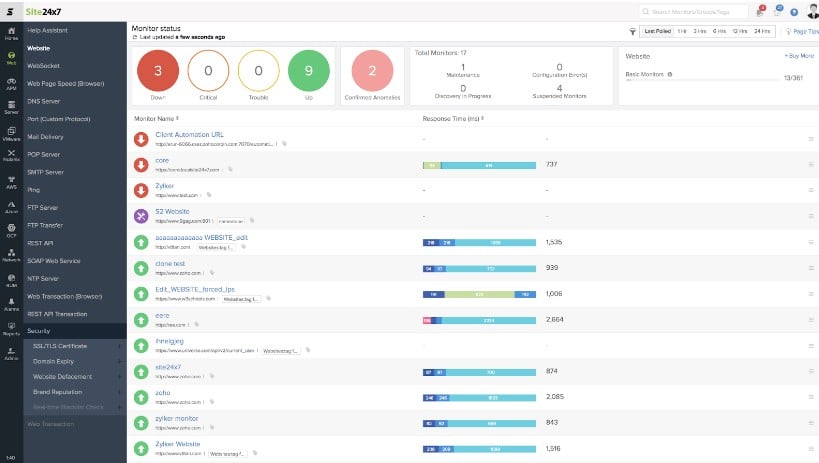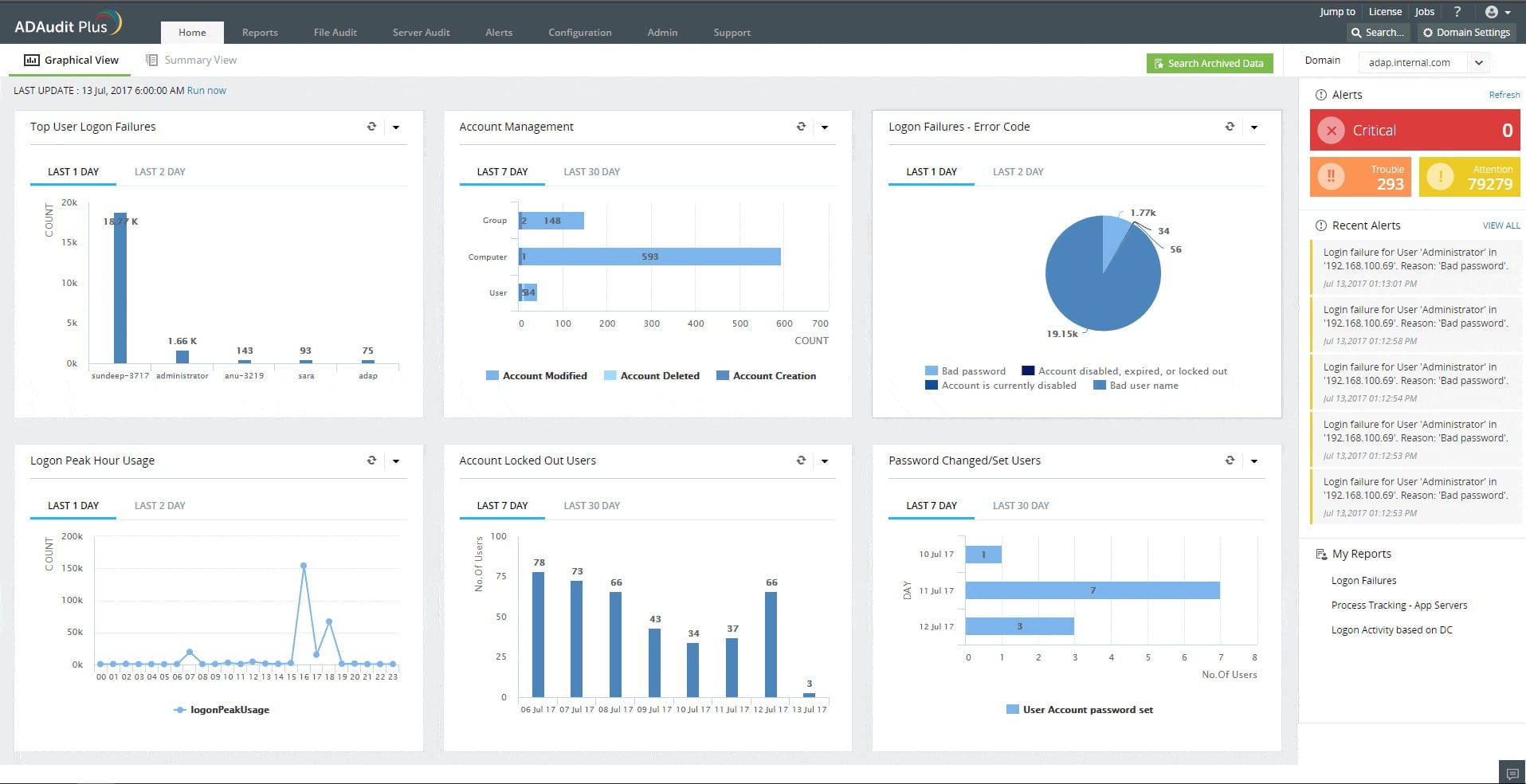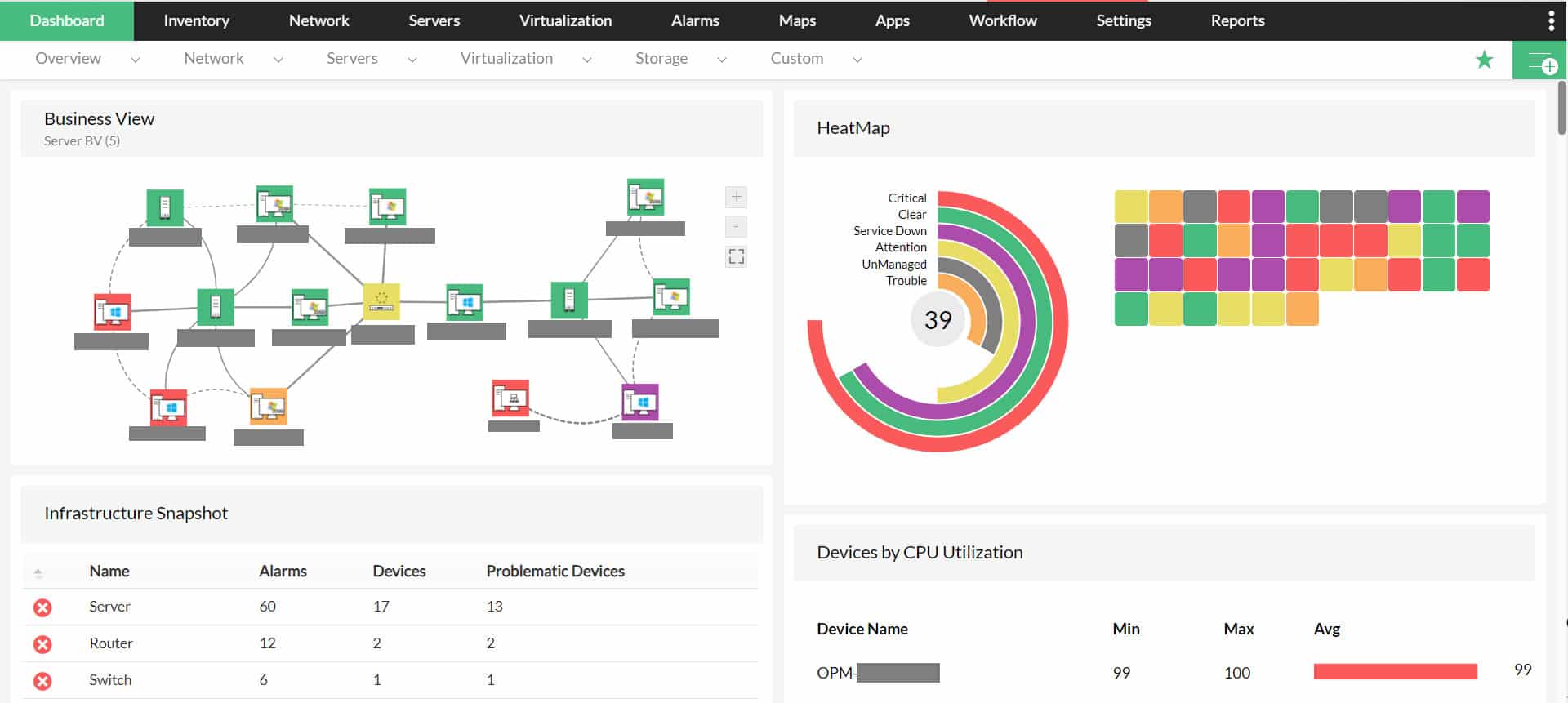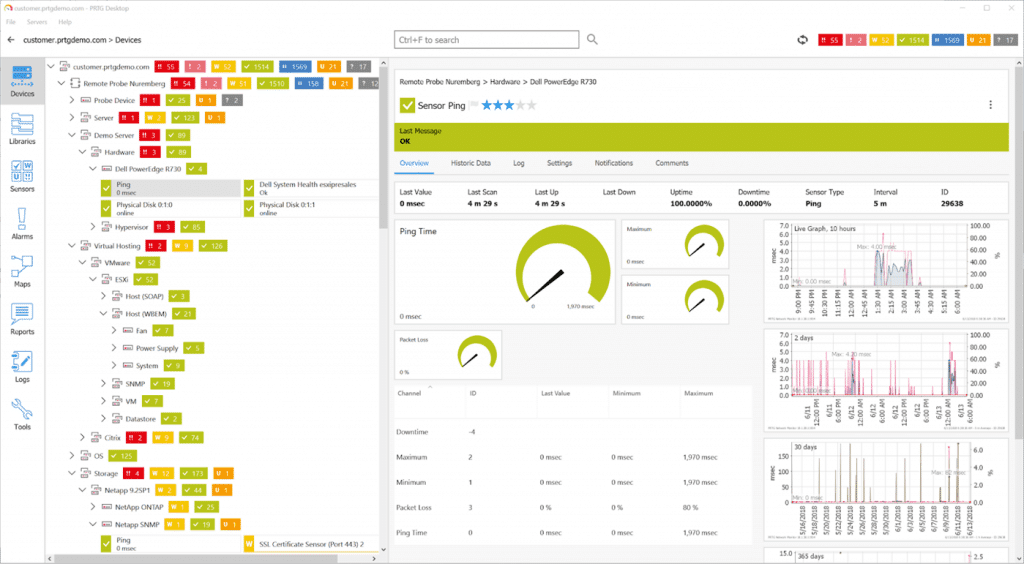We may earn a commission if you make a purchase through the links on our website.
NetApp Monitoring Software and Tools for the Best Management of your Devices
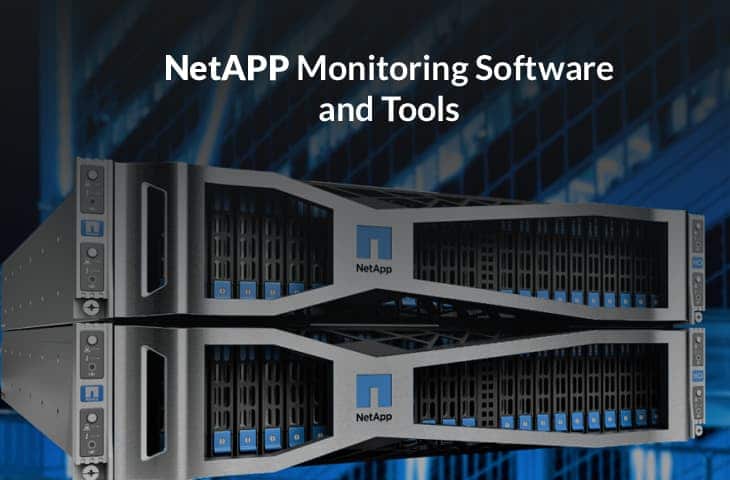
UPDATED: July 10, 2024
NetApp is strongly focused on storage hardware, its management software, and on data services for the clouds – we're going to cover NetApp Monitoring and see which programs can assist with monitor this critical infrastructure device. The storage devices are commonly used by large businesses to store and transfer large quantities of data across hybrid clouds.
The main types of hardware include hybrid cloud infrastructure and flash storage. Its storage systems can integrate with all leading cloud providers, and can also natively support VMware VSphere.
Here is our list of the top NetApp Monitoring tools:
- Site24x7 Network Monitoring – FREE TRIAL This cloud-based service provides device health checks plus traffic flow data for live monitoring and historic analysis. Start a 30-day free trial.
- ManageEngine ADAudit Plus – FREE TRIAL A file integrity monitoring tool that includes logging for NetApp files and CIFS. Available for Windows Server, Azure, and AWS. Start a 30-day free trial.
- ManageEngine OpManager – FREE TRIAL Excels at NetApp monitoring with comprehensive real-time insights, customizable dashboards, and automated alerts, making it a top choice for storage management. Start a 30-day free trial.
- PRTG NetApp Health Sensor – FREE TRIAL A collection of monitors for networks, servers, and applications that includes a sensor for NetApp environment monitoring. Runs on Windows Server. Start a 30-day free trial.
- NetApp Active IQ Unified Manager A monitoring solution for hybrid environments that can summarize and unify the monitoring of resources based on both the cloud and on premises. Available for Windows Server and Linux.
- Nagios Netapp Monitoring A monitoring system that is available in free and paid versions that has plugins to add on NetApp monitoring capabilities. Installs on Linux or over a hypervisor for Windows.
- IntelliMagic Vision for SAN This flexible SAN monitoring tool can monitor all major storage hardware arrays, including NetApp FAS system. This system provides AI-based performance analysis and alerting. Available as a cloud service.
- SolarWinds NetApp Storage Performance Monitoring This NetApp monitoring solution is part of the SolarWinds Resource Monitor and it covers an overview and detailed analysts of storage solution performance. Runs on Windows Server.
- LogicMonitor NetApp Monitoring A cloud-based service that can monitor physical and virtual resources no matter where they are located.
- Netwrix Auditor for NetApp A system monitor that is available in free and paid versions and is able to cover combinations of physical and virtual systems, including NetApp environments. Runs on Windows Server.
- OpsView Monitor An extensible monitoring system for applications and servers that includes a NetApp service monitoring extension. Available for Linux or as a cloud service.
The Best NetApp Monitoring Software and Tools
Our methodology for selecting NetApp monitoring tools
We reviewed the market for NetApp storage monitoring software and analyzed the options based on the following criteria:
- A package that can track the performance of the different NetApp storage configurations
- A solution that is able to coordinate the monitoring of clusters
- A system of alerts that track both demand and capacity availability
- Integration with the NetApp device operating system
- The ability to monitor storage devices on multiple sites plus cloud platforms
- A free trial or a demo package that lets you try before you buy
- Value for money from a monitoring package that squeezes cost savings from storage
In this post, we will review the following tools which will help you keep track of those NetApp resources.
1. Site24x7 Network Monitoring – FREE TRIAL
Site24x7 Network Monitoring is part of a suite of system monitoring services that are delivered from a cloud platform. This package provides both network performance monitoring and bandwidth analysis. The Network Monitoring system is bundled in with monitors for applications, servers, and Web assets, so you get full stack monitoring services with this deal.
Key Features:
- Monitors Network Devices with SNMP: Includes storage device monitoring
- Full Stack Monitoring Package: Plans monitor networks, servers, services, applications, and Web systems
- Alerts for Device Status Faults or Capacity Exhaustion: Can be forwarded by email, SMS, or voice call
Why do we recommend it?
Site24x7 Network Monitoring tracks SAN systems through the Simple Network Management Protocol. This system operates through an on-device agent that sends out regular status reports. These reports include information about component failure and capacity issues and that data gets shown in the Site24x7 dashboard. Problems get interpreted into alerts.
The package uses the Simple Network Management Protocol (SNMP) to constantly poll device agents for status reports. These responses provide details of component statuses and activity data. The other strand of this network supervision system communicates with switches using the NetFlow, J-Flow, sFlow, CFlow, IPFIX, NetStream, and AppFlow protocols to compile bandwidth capacity and utilization statistics.
Who is it recommended for?
Site24x7 is a SaaS platform with subscription packages that cover all levels of the service stack. This is an affordable solution for any size of business. The company provides base packages that are suitable for small businesses and scales up for larger organizations through expansion supplements. SNMP monitoring will track network devices along with its SAN and server monitoring capabilities.
Pros:
- Flexible Monitoring Platform: A library of monitoring system extensions
- Full Stack Observability: Shows dependencies within the application stack
- Root Cause Analysis: Enhanced by AI
Cons:
- No On-Premises Version: Only available as a SaaS platform
Site24x7 is a cloud service and so you sign up for the system on its website rather than downloading a file. You can get the service on a 30-day free trial.
The Infrastructure monitoring package, which includes the Network Monitoring modules starts at $9 per month.
2. ManageEngine ADAudit Plus – FREE TRIAL
ManageEngine ADAudit Plus logs file-related activity on servers and workstations. The capabilities of the tool include special procedures for tracking activity with NetApp filer and CIFS shares. The tool also alerts for unauthorized changes in Active Directory.
Key Features:
- NetApp Filter Activity Tracking: Also NetApp CIFS shares auditing
- Alerts for NetApp Configuration Changes: See who made those changes and what they changed
- Compliance Auditing: For SOX, HIPAA, PCI-DSS, FISMA, and GLBA
Why do we recommend it?
The name of ManageEngine ADAudit Plus is a little misleading because this package isn’t just for scrutinizing Active Directory, it offers much more. The tool accesses AD for user information because its real purpose is user activity tracking. This package is designed to implement insider threat detection and it will also protect against account takeovers.
Although tracking file activity is important, you should really focus on Active Directory entries to ensure that only authorized users are getting into your files. You need to make sure that hackers haven’t tricked your valid users into giving away their credentials, which is why the user behavior analysis module in ADAudit Plus is important.
Who is it recommended for?
This package provides an important service for all types of businesses because it looks for duped or disgruntled employees who could damage the profitability of the enterprise. The ADAudit Plus system is particularly necessary for businesses that hold personally identifiable information and risk fines and reputational damage if any of it is disclosed or misused.
Pros:
- File Integrity Monitoring: Records all actions on files that have been designated for protection
- User Behavior Analysis (UBA): Insider threat detection
- Log File Analysis: Provides opportunities for manual threat hunting
Cons:
- Not a SaaS Package: It is available for installation on AWS and Azure as well as for Windows Server
There is a Free edition for monitoring up to 25 workstations. Two paid versions are:
- Standard: Implements file integrity monitoring from $595
- Professional: Adds on Active Directory DC protection from $945
Get a 30-day free trial.
3. ManageEngine OpManager – FREE TRIAL
ManageEngine OpManager excels in NetApp monitoring by providing comprehensive, real-time insights into the performance and health of NetApp storage systems. By proactively detecting storage performance issues, it helps avoid bottlenecks that can cripple business-critical operations, such as overshooting data capacity, improper resource allocation, and setbacks in I/O processes. OpM’s customizable dashboards and data visualization tools offer a detailed view of NetApp metrics, enabling precise capacity planning and ensuring data security.
Key Features:
- NetApp Monitoring: Provides comprehensive monitoring of NetApp storage systems, including performance metrics and health status.
- Real-Time Monitoring: Continuously monitors NetApp devices in real-time, ensuring immediate detection of performance issues.
- Customizable Dashboards: Allows for the creation of tailored dashboards to view specific NetApp performance metrics and system health.
- Automated Alerts: Sends notifications based on predefined thresholds for NetApp storage performance, enabling proactive issue management.
Automated alerts based on predefined thresholds ensure timely notifications of potential problems, allowing IT administrators to address issues before they escalate into serious threats. Additionally, the integration with other IT management tools and the use of StorageRESTAPI for monitoring latency, throughput, and IOPS make OpM a powerful solution for managing NetApp storage appliances effectively. With features like extensive monitoring of supplementary NetApp characteristics and holistic dashboards, ManageEngine OpManager is a great choice for NetApp performance monitoring.
Pros:
- Comprehensive NetApp Monitoring: Provides detailed insights into the performance and health of NetApp storage systems.
- Real-Time Insights: Offers continuous, real-time monitoring, enabling quick detection and resolution of performance issues.
- Customizable Dashboards: Extensive customization options allow users to tailor performance views to their specific needs.
- Proactive Alerts: Sends automated notifications based on predefined thresholds, ensuring proactive issue management.
- Detailed Reporting: Generates comprehensive reports on NetApp performance, aiding in effective decision-making.
- Seamless Integration: Integrates easily with other IT management tools, enhancing overall efficiency.
- Scalable Solution: Suitable for organizations of all sizes, allowing easy scalability as your business grows.
Cons:
- Learning Curve: The wide array of NetApp monitoring features can be overwhelming for new users.
- Resource Intensive: Can be demanding on system resources, potentially affecting performance.
- Complex Initial Setup: The initial configuration process for comprehensive NetApp monitoring can be time-consuming.
- Higher Cost: Some advanced NetApp monitoring features may require additional financial investment.
- Occasional False Alarms: Users may experience occasional false alarms due to sensitive thresholds.
Start by downloading a 30-day free trial.
4. PRTG NetApp Health Sensor – FREE TRIAL
PRTG Network Monitor is a popular software among IT and network admins. It can help monitor every component in an IT infrastructure, form the network, the systems, applications, storage, traffic, databases, security, virtual, hardware, and a lot more.
Key Features:
- Health Status Checks: Includes availability and response times
- CPU Usage Monitoring: Watches that the NetApp operating software has sufficient resources
- Storage Usage Logs: Track activity volumes
Why do we recommend it?
The PRTG NetApp Health Sensor is just one of the monitoring units within the PRTG package. This software is actually a package of many monitors, which are all called “sensors.” You can use this service to monitor NetApp systems, other SAN services, and any other type of server.
The magic of PRTG Network Monitor is its sensors, which are monitored elements within a device. With these sensors, you can keep track of a single element, for example, IOPS, physical disk, or system health. You can run from one PRTG sensor to up to hundreds of sensors in a single device.
An excellent sensor to monitor NetApp is the SNMP NetApp System Health. It uses the Simple Network Management Protocol (SNMP) to keep track of your NetApp storage. It can monitor information such as:
- CPU load
- Used disk space
- Active restores
- Active disks
- Failed disks
- Spare disks
- Failed fans
- Failed power supplies
- Temperature
- And more.
Who is it recommended for?
PRTG is a suitable monitoring package for any business, not just those that use NetApp for their storage solution. This package will also monitor other types of servers plus networks, middleware, cloud platforms, and web applications. Small businesses will be interested in the Free edition, which provides 100 sensors at no charge.
Pros:
- Full Stack Observability: Monitors networks, servers, and applications
- Customizable Dashboard: Rearrange the screens in the console to suit your priorities
- Deployment Options: Available as a software package for Windows server or as a SaaS platform
Cons:
- No System Management Features: PRTG is purely a monitoring package
PRTG's pricing is based on the number of sensors, starting at $1,330 for PRTG500, allowing up to 500 sensors monitoring. Download PRTG100 for free to test the NetApp Health Sensor indefinitely, or apply for a fully functional 30-day free trial to test the product with more than 100 sensors.
5. NetApp’s Active IQ Unified Manager
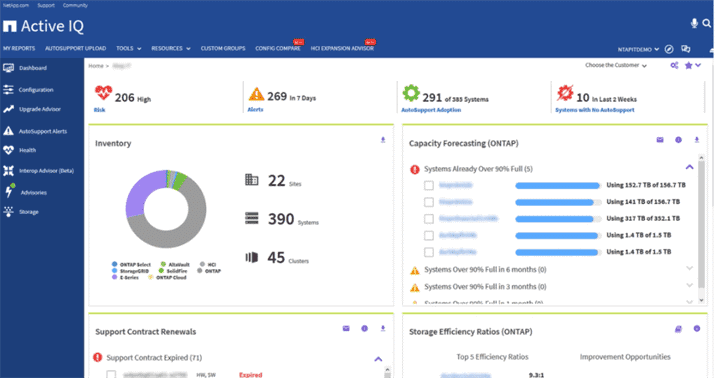
The active NetApp IQ Unified Manager is a management and analytics tool for the NetApp ONTAP systems. The software allows you to monitor, manage, and improve the FAS and AFF storage performance and capacity. With the IQ Unified Manager, you’ll be able to keep your storage infrastructure under control and improve security, scalability, and supportability.
Key Features:
- Discovers and Monitors Storage: Operates on ONTAP storage solutions
- Notifications System: Alerts for performance problems
- Manage and Monitor Petabytes of Data: Designed for data centers
Why do we recommend it?
NetApp Active IQ Unified Manager is a product from NetApp that interacts with the proprietary ONTAP operating system. This package can interface in a direct manner with the storage management services of a NetApp package, which includes FAS, AFF, ONTAP Select, and Cloud Volumes ONTAP. Monitor and manage storage clusters with this package.
The software allows you to keep track of your storage resources by sending regular health checks and alerting accordingly. You can view all unified details from a single pane of glass and react to any alarm with the recommended steps.
You can install the Active IQ Unified manager in a Linux or Windows server or as a VMware host.
Who is it recommended for?
Any business that uses the NetApp system would benefit from this package. It comes directly from NetApp, so it integrates into the ONTAP operating system. See live data on activities for individual storage devices and across clusters. The tool also offers channels for automated remediation actions when things go wrong.
Pros:
- Supports Both FAS and AFF Storage Options: Manages on-premises and cloud systems
- Offers a Single View for All Your NetApp Monitors: Unit and cluster views
- Includes Auto-Remediation: Fixes problems before humans have time to react
Cons:
- Deals with Complex Storage Configuration: Not optimal for small implementations
You can request a quote. There is no free trial.
6. Nagios Netapp Monitoring
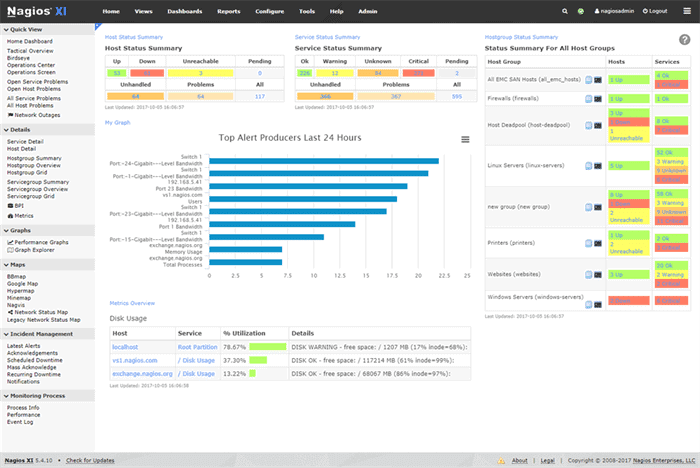
Nagios develops two distinct but powerful infrastructure monitoring tools, the Nagios Core and Nagios IX. The Nagios Core is the free and open-source version of the enterprise monitoring tool, the Nagios IX. Both tools can monitor storage, filesystem, files, directories, NAS, DAS, RAID Arrays, EMC, NetApp, and a lot more.
Key Features:
- Plug-In for the Nagios Monitoring System: Adds on extra screens to the dashboard
- Extends the Capabilities of the Base Nagios Package: Available for Nagios XI and Nagios Core
- Capabilities for Many Storage Configurations: NAS, DAS, RAID Arrays, and EMC
Why do we recommend it?
Nagios is a system-wide monitoring package and it isn’t limited to monitoring NetApp systems. The service has an associated library of plug-ins, called Nagios Exchange. Many plug-ins are provided by the user community and there are also official systems offered for free by technology providers.
The Nagios Software can keep track of NetApp appliances, their filesystem usage, and free space. It can also monitor the essential elements from a NetApp ONTAP cluster, such as volumes, snapshots, quotas, fillers, and overall disk health.
The Nagios software comes with amazing alerting features to keep you informed when there’s a problem with a disk or a volume. You can see alerts in the single dashboard or get the software to send them to your email, or text you. You can also take advantage of the reporting system, to get all your Netapp clusters information into an organized report generated by the software.
Who is it recommended for?
Nagios is a full-stack monitoring system and Nagios Exchange gives the service the ability to monitor just about any IT technology. The system is available in a paid version, called Nagios XI, and a free system, called Nagios Core. Both versions accept the NetApp monitoring plug-ins from Nagios Exchange. The only problem with this system is that it isn’t available for Windows.
Pros:
- Open-Source Transparent Tool: Runs on premises
- Alerting Mechanism: Forwards alerts as notifications by SMS and email
- Full Stack Monitoring: Tracks the performance of network devices, servers, services, software, and Web applications
Cons:
- The Software Won’t Run on Windows: Run it over a VM or on Docker
Nagios Core is free and open-source, and Core XI starts at $1,995 for a standard license. Get a fully-featured and free Nagios Core download, or get a 60-days-trial version of the Nagios XI.
7. IntelliMagic Vision for SAN
IntelliMagic Vision for SAN includes the monitoring of NetApp environments in its SAN monitoring service. This monitoring system is able to unify the monitoring of services provided by many different vendors and make them manageable from one interface. This system can identify performance and resource issues and then analyze the causes of the problem and suggest solutions.
Key Features:
- Autodiscovery: Identifies all of the services contributing to a NetApp environment
- Constant Monitoring: Shows live statuses
- Space Requirements Forecasting: Predicts resource requirements
- Analysis of SAN Fabric Paths: Root cause analysis
- Segmented Metrics: Performance statistics per protocol
Why do we recommend it?
IntelliMagic Vision for SAN is able to monitor NetApp hardware as well as the SAN systems of other producers. The monitoring package looks at all contributing components to connecting storage to applications and managing the different storage media that can be used to mirror data as well as primary stores.
The system includes AI routines to calculate how complicated application and resource inter-dependencies can impact on resources, spotting when issues are probably going to arise, rather than waiting for the problem to occur. This buys you time to adjust resource allocations before they impact on performance.
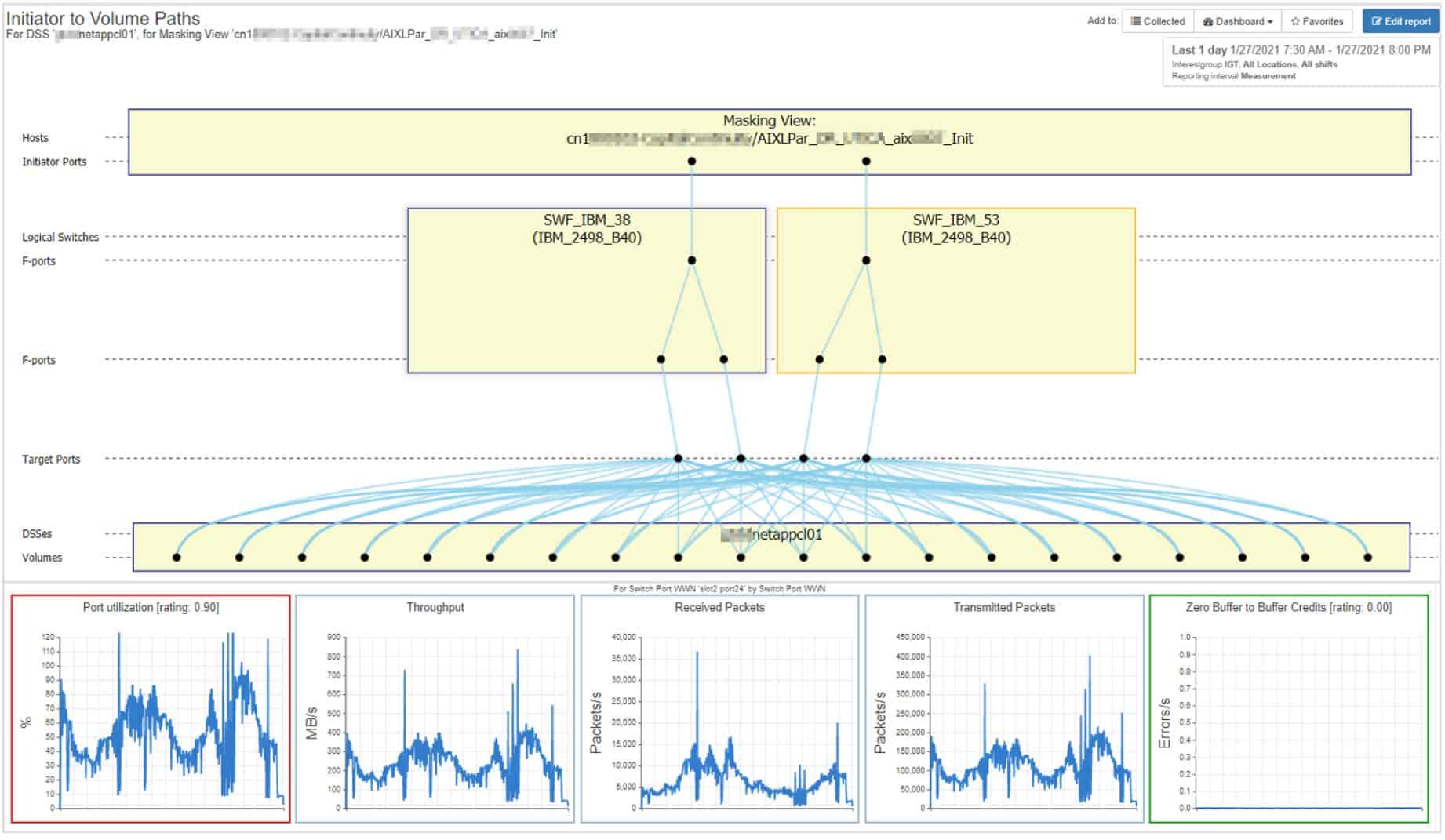
IntelliMagic Vision is available as a virtual appliance over VMWare or as a cloud service.
Who is it recommended for?
This is a good choice for any business that uses a NetApp SAN system. The service can be run on the cloud or on your own servers, which expands the audience for this tool. The IntelliMagic service uses AI to manage complicated multi-media storage systems and work out potential delivery bottlenecks before they actually impair performance.
Pros:
- Coordinate Storage Activities Across Your Environment: Utilizing different media
- Leverages AI to Aid in Capacity Planning: Tracks complicated dependencies
- Highly Customizable Admin Dashboard: Prioritize those indicators that mean more on your site
- Predictive Alerts: Spots problems before they occur
- Historical Analysis: Spots patterns in usage activity
Cons:
- Not a Small Business Tool: Better suited for enterprises and data centers
Contact the Sales Department to get a quote. You can request a free trial of IntelliMagic Vision for SAN.
8. SolarWinds NetApp Storage Performance Monitoring
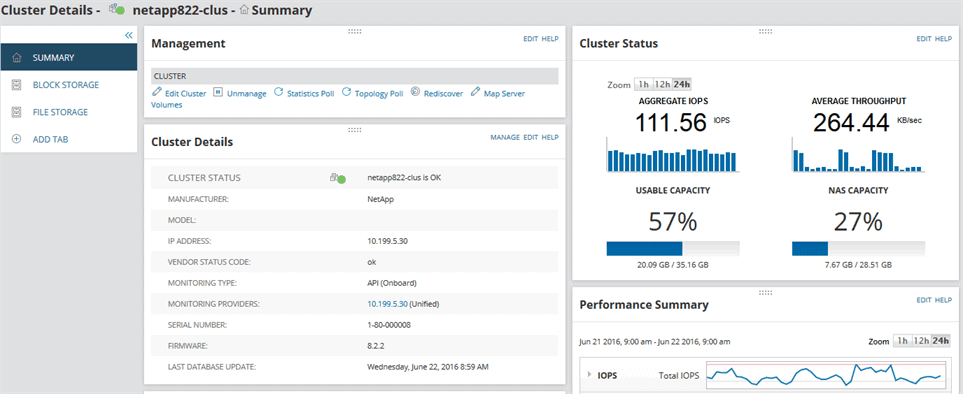
The NetApp Storage Performance Monitoring software developed by SolarWinds, helps you gain deep insights on the performance of all your NetApp arrays and get storage views. The software comes within the Storage Resource Monitor SRM, which is a storage management tool that supports multi-vendor devices.
Key Features:
- The Storage Resource Monitor: Runs on Windows Server
- Performance Metrics: IOPS, average throughput, NAS capacity, usable capacity, and latency
- Capacity Planning Support: Records storage consumption over time
- Resource Shortage Alerts: Can be sent by SMS or email
Why do we recommend it?
SolarWinds Storage Resource Monitor is able to monitor all types of storage management services, not just NetApp systems. The package looks for bottlenecks in services to identify potential performance problems. This can involve a range of technologies, so the tool is able to perform dependency mapping to know which components it should watch over.
With the NetApp monitor, you can perform health checks and identify possible bottlenecks on your NetApp storage. You can also check the cluster at different levels, from the filer, the RAID groups, to the volume.
The software comes with the main dashboard or “Summary” that shows you all details about the cluster and its current status. From the same page, you can also manage the cluster and get a performance summary.
The SolarWinds NetApp Storage Performance Monitoring will:
- Monitor your performance metrics, including, IOPS, average throughput, NAS capacity, usable capacity, and latency.
- Provide proactive capacity planning, by tracking historical storage consumption data and predicting when the storage will be finished.
- Provide insightful reports and alerts to help you troubleshoot faster.
Who is it recommended for?
This is a solution for large organizations, which is the typical market for NetApp storage management systems. The SolarWinds system is an on-premises software package that runs on Windows Server. The tool creates efficiency by automating NetApp monitoring, raising alerts if performance problems arise. This frees up technician time for other tasks.
Pros:
- Multi-Vendor Environments: Isn’t limited to monitoring NetApp systems
- Tracks Activity: Filers, group management, and throughput volumes
- Easily Manage Multiple Complex Storage Setups: Such as RAID arrays
- Crisis Simulation: Rerun past events to recreate outages and performance problems to analyze possible causes
Cons:
- No SaaS Option: Only available for self-hosting on Windows Server
Fully-functional free trial of SolarWinds NetApp Storage Performance Monitoring for 30 days.
9. LogicMonitor NetApp Monitoring
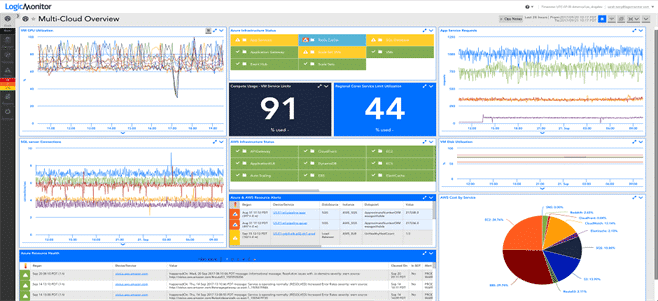
LogicMonitor is a SaaS-based performance and health monitoring platform for all kinds of IT infrastructure. It comes with over +1500 integrations so you can monitor any server, cloud, VMs, network, applications, websites, storage, websites.
Key Features:
- Monitoring for Servers: On-premises and cloud servers
- NetApp Integration: Provided as an extension to the core package
- AI-Driven Event Correlation: Examines multiple dependent technologies simultaneously
Why do we recommend it?
LogicMonitor is a cloud-based infrastructure and application monitoring service that offers an AI module to identify the connections between different systems. Not every buyer of LogicMonitor uses NetApp, so the NetApp monitoring tool isn’t included in the core Infrastructure package. However, it is available as an integration.
The NetApp monitoring comes as one of those integrations. It is already pre-configured, and you can also customize it to your needs. With it, you can keep track of your NetApp performance, trends, and alerts.
LogicMonitor can keep track of a variety of metrics, such as:
- Active Interfaces.
- CPU Usage.
- Disk Activity.
- IOPS (IO per second)
- Per volume space.
- Inode and snapshot utilization.
- LUN queue depth.
- And a lot more.
Logic Monitor comes with a highly visual dashboard, which shows you the information in real-time. The dashboard also shows you the alarms, from critical to low importance, and the recommended actions to take.
Who is it recommended for?
This monitoring service is strong at monitoring hybrid systems. However, the monitoring services for on-premises systems are included in the Infrastructure monitoring plan and the cloud system monitoring services are in the Cloud IaaS monitoring unit, so you don’t have to take all of those cross-platform capabilities if you only use on-premises services or only have cloud-based systems.
Pros:
- SaaS Package: Monitors application performance via the cloud
- Good for Monitoring Hybrid Systems: Sign up for different modules accordingly
- Scalable Pricing: Subscription rates are levied per resource
Cons:
- Not Strong at Network Monitoring: Focuses on servers and applications
There are three different licenses, the Starter, Pro, and Enterprise. To know the price, request a quote. To get a 14-days free trial, sign up to LogicMonitor.
10. Netwrix Auditor for NetApp
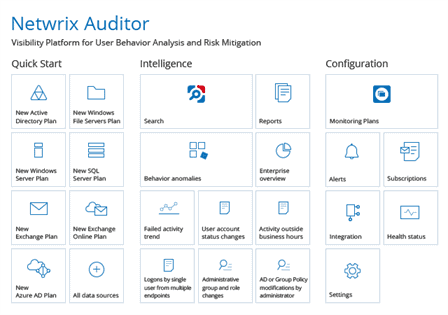
Netwrix Auditor is an agentless data security platform that provides visibility for user behavior analysis and risk mitigation. Netwrix helps protect your Netapp filers by monitoring their health, access events, sensitive files, user activity, etc. The software will also discover IT risks that may put data or users in danger.
Key Features:
- Part of the Network Device Monitoring Services: NetApp monitoring is implemented through SNMP
- Performance Monitoring: See resource usage and identify shortages
- Security Monitoring: Watch out for irregular activity
Why do we recommend it?
Netwrix Auditor uses two methods to monitor NetApp systems. First, it checks on the availability and health of each component of your server clusters. It also collects and scans through logs. These are generated by the NetApp ONTAP system management layer. The Netwrix package looks for warnings in those messages.
The Netwrix Auditor for NetApp collects all filers event logs, analyzes them, and shows them in a readable format. The dashboard displays the results, including success or attempted access, violation in a set of permissions, and more.
You can get the Netwrix NetApp monitor through the free edition, which includes many of the features discussed above except, the “State-in-time reports on NetApp filer configuration,” which comes with the commercial license.
Who is it recommended for?
This package is useful for both performance monitoring and security scanning. The service acts like a SIEM and it collects and analyzes logs, also taking a feed of live network activity from SNMP. The service isn’t just reserved for companies that use NetApp. It can monitor all types of storage systems also with processing servers, applications, and networks.
Pros:
- Log Collection and Scanning: Provides system-wide security monitoring
- Alerts for Performance and Security Issues: Technicians get notified if their attention is needed
- Automated Remediation is Possible: Define triggers to launch scripts
Cons:
- Not Available for Linux: This on-premises software package will run on Windows or Windows Server
To get information for commercial licenses, request a quote from Netwrix official site. You can get a fully-functional for free for 20 days, after that time you’ll have to either activate the Free Community Edition or apply for a commercial license.
11. OpsView Monitor NetApp
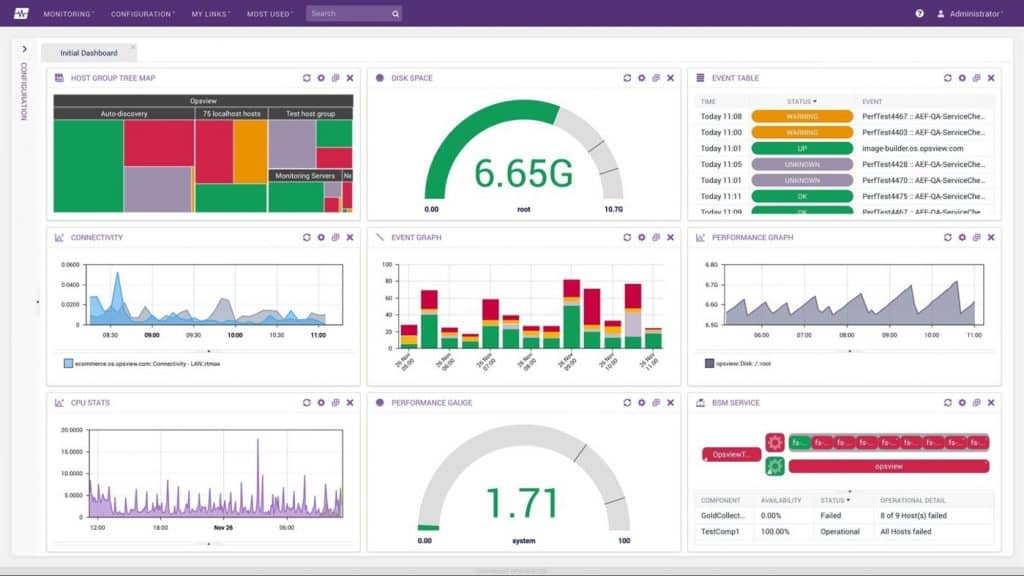
OpsView is a unified cloud and infrastructure monitoring software. It can run anywhere, on bare metal, on VMs, on the cloud, or on-premises. It supports thousands of plugins and can integrate, out-of-the-box with popular applications like VMWare vSphere, Docker, AWS, Azure, Cisco, Office 365, Jira, NetApp, and more.
Key Features:
- Deployment Options: On-premises and cloud-based versions
- Full Stack Observability: Monitors networks, servers, services, cloud platforms, software, and Web applications
- Expandable Monitoring Service: Add NetApp monitoring with an opspack
Why do we recommend it?
OpsView Monitor is a similar service to the Nagios XI but this system is also available as a SaaS platform. This system implements NetApp monitoring through the activation of an extension. The core system gives you all of the central monitoring tools you will need for a standard IT system that has both on-premises and cloud elements to manage.
OpsView supports NetApp monitoring as part of its Systems Monitoring Opspacks. With the Opsview Monitor’s NetApp you can keep track of the following metrics on a NetApp server:
- Uptime status.
- CPU load
- Disk read and write usage.
- State of hard disk, fans, and PSU.
- Free vs. the used space.
- Temperature and voltage.
- And a lot more.
The OpsView Monitor will display your NetApp data in real-time in its interactive dashboard. It will also display alarms or send them to your email or via text. And what is best is that it can also create visual reports, such as performance reports, SLA reports, and events reports.
Who is it recommended for?
This package is priced per host with the SaaS platform working out more expensive than the on-premises version – the SaaS includes cloud storage space. The scaleable pricing means that the Opsview system is suitable for businesses of all sizes. One problem that some businesses will have is that the on-premises software isn’t available for Windows.
Pros:
- Gather Logs for Extra NatApp Data Sources: Good for manual analysis as well as automated monitoring
- Autodiscovery: The package will discover and document your entire system
- Integrations with Analysis Tools: Send data to Splunk or Elastic Stack for analysis
Cons:
- Won’t Run on Windows: Businesses that only have servers running Windows can run it over a VM
OpsView has three different pricing plans, Free, SMB, and Enterprise. Free plan for up to 25 hosts. The SMB plan for 50 hosts for $95.00/month (includes all standard features). And Enterprise for over 300 hosts and comes fully featured, for more information, schedule a demo. Get free OpsView monitoring for up to 25 hosts for an unlimited time.
Summary
NetApp is the king when it comes to storing and managing your data. They have everything in line, from software, hardware, to systems and services to manage and store data.
Although Netapp has great monitoring solutions, you can always get leverage with other tools to check the health and performance of your storage.
The monitoring tools mentioned above are pretty complete. The good thing is that you’ll be able not only to keep those NetApp resources in good shape, but you’ll also have access to monitoring other aspects of your infrastructure.
